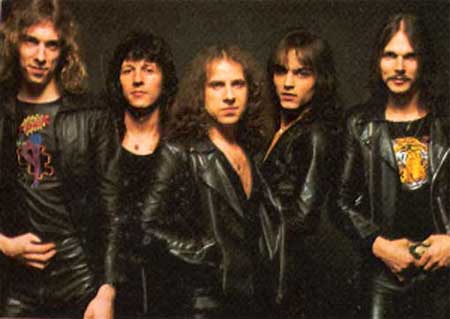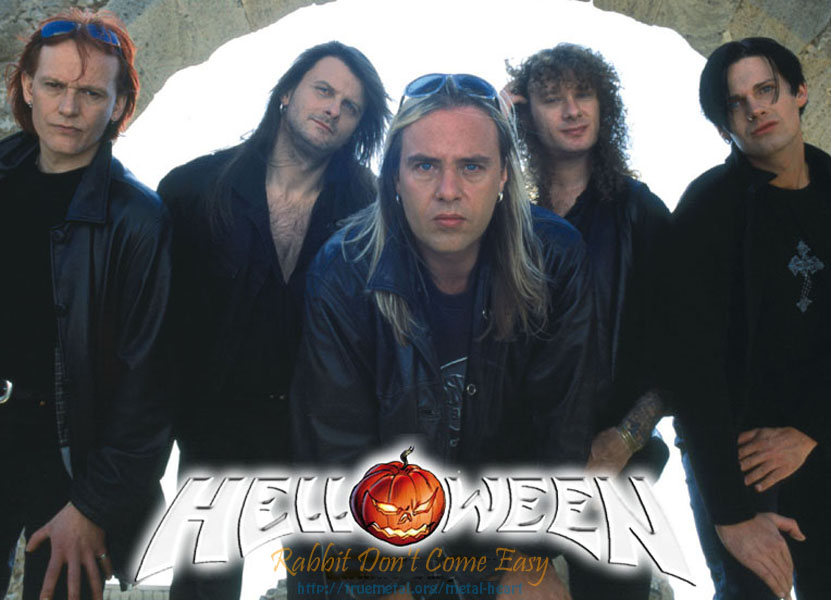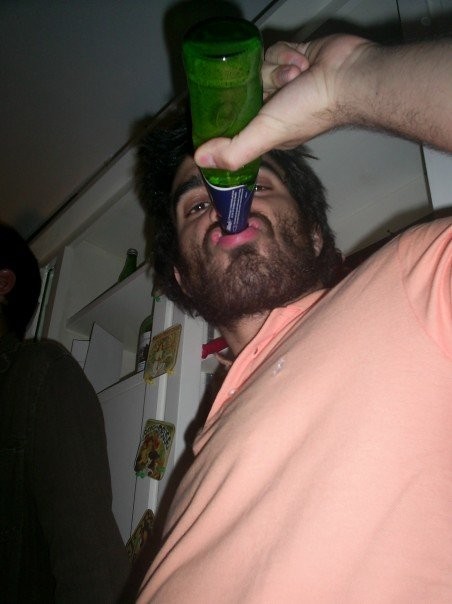των μουσικών
- Σύνθεση Μουσικής
- Συναντήσεις & δικά μας live
- Κιθάρα & έγχορδα
- Πιάνο & πληκτροφόρα
- Φωνητική
- Drums & κρουστά
- Πνευστά
- Εξοπλισμός - Ηχοληψία
- Μουσικό Software
- Μουσική εκπαίδευση - Θεωρία
- Νομικά, εργασιακά, ασφαλιστικά
- Οι Δημιουργίες μας
της μουσικής
- Μουσικές Συζητήσεις
- Καλύτερα, χειρότερα & αγαπημένα
- Νέες κυκλοφορίες
- Συναυλίες & Events
- Στίχοι, Τραγούδια, Παρτιτούρες
του λαού
τα εν οίκω
Γερμανικά Ροκ Συγκροτήματα
Πριν λίγες μέρες είδα στο θερινό σινε - Ψυρρή την ταινία "Η ΑΛΙΚΗ ΣΤΙΣ ΠΟΛΕΙΣ" του Βιμ Βέντερς [πολύ ωραία ταινία, την προτείνω]. Τη μουσική σε αυτήν την ταινία υπογράφουν οι "πατεράδες" του Γερμανικού kraut rock, οι CAN [η μουσική της ταινίας ήταν ως επί το πλείστον πλημμυρισμένη από τα "χαλαρά" κιθαριστικά ψυχεδελικά αρπέζ των Can]. Έτσι ... μού ήρθε η "φλασιά" να ανοίξω τόπικ με θέμα ΓΕΡΜΑΝΙΚΑ ΡΟΚ ΣΥΓΚΡΟΤΗΜΑΤΑ. Γιατί, ως γνωστόν, όταν οι Γερμανοί κάνουν ροκ, ΤΟ ΚΑΝΟΥΝ ΜΕ ΤΟΝ ΚΑΛΥΤΕΡΟ ΤΡΟΠΟ.
Θα μού άρεσε να διαβάσω παρουσιάσεις συγκροτημάτων ή δίσκων, απόψεις σας κλπ για όποιον καλλιτέχνη εκ Γερμανίας γουστάρετε : Για το "kraut rock" κίνημα [Can, Faust, Neu! κλπ] .... για την [καταπληκτική] χέβι - θρας μέταλ σκηνή της Γερμανίας .... για τους Einsturzende Neubauten .... για τους Eloy .... Κι αν κάποιοι από εσάς έχετε υπόψη σας κάποιο συγκρότημα από αυτή τη χώρα που δεν είναι ευρέως γνωστό αλλά αξίζει να το ανακαλύψουμε .... ας το πει και σε μας να το μάθουμε [ας μην ξεχνάμε, άλλωστε, ότι οι περισσότερες γερμανικές ροκ μπάντες επέλεξαν να σταδιοδρομήσουν για πολλά χρόνα τελείως "αντεργκράουντ" ... τελικά αυτός ο λαός έχει κάποια χαρακτηριστικά που ... σε κάνουν να του βγάζεις το καπέλο !!!] ...
Goodbye Lenin!
(αφου δεν βρηκα καμια γερμανικη μπαντα που να μ αρεσει, ιδου η πιο ωραια ταινια που αφορα την Γερμανια!)
Από παλιότερες δεκαετίες θα αναφέρω πρώτα τους City, που είναι γνωστοί μόνο για το Am Fenster, αν και ολόκληρο το ομότιτλο CD τους είναι καταπληκτικό. Επόμενη αναφορά οι Kraftwerk, οι πρωτοπόροι (μαζί με τους Tangerine Dream) της ηλεκτρονικής μουσικής (από CD προτείνω το κλασσικό Autobahn αν είστε λάτρεις του αυτοκινήτου και το σχετικά πρόσφατο Tour de France αν είστε λάτρεις του ποδηλάτου), Σε πιο rock/punk, τα πιο γνωστά συγκροτήματα είναι Die Δrzte και Die Toten Hosen. Από πιο σύχρονες μπαντες, ενώ έχω ακούσει αρκετά κομμάτια, δεν έχω κπάποιο cd, ώστε να εκφέρω γνώμη.
Από καλλιτέχνες ξωχωρίζω τον Herbert Grφnenmeyer (το CD του με τίτλο Mensch είναι το αγαπημένο μου από γερμανόγωνο rock), ενώ από καλλιτέχνιδες τη Nena και τη Nina Hagen.
Από τα αγγλόφωνα σχήματα, ξεχωρίζω τους Eloy, που κατά τη γνώμη μου θα μπορούσαν υπό άλλες συνθήκες να έχουν την φήμη και την καταξίωση των Pink Floyd, τους Blind Guardian, που είναι το αγαπημένο μου power metal συγκρότημα, και φυσικά τους Scorpions, γιατί με αυτούς μεγάλωσα (όπως και πάρα πολύς κόσμος στην Ελλάδα).
ένας από τους πρώτους μου δίσκους ήταν το Yeti των Αmon Duul.Πολύ ψυχεδέλεια και τα σπάνε πραγματικά ξεκίνησαν το 1966 και συνέχισαν για πολλά χρόνια με διάφορες αλλαγές στα μέλη τους (τα πρώτα χρόνια έμεναν όλοι μαζι σε ένα κοινόβιο) αξίζει να τους ψάξεις και σου παραθέτω μια πολύ καλή παρουσίαση της ιστορίας τους
Amon Duul II were perhaps the most "teutonic" among the great German masters of the 1970s. Their sound was "gothic" in the most authentic (and least sensational) sense of the word. Their cultural roots led them to gothic atmospheres, not their self-indulgence. At the peak of their art, Amon Duul II wed that teutonic/gothic element with the musical freedom of psychedelia.
They soon abandoned the most blasphemous and provocative stances, and their sound more clearly revealed the influence of Californian acid-rock. Their musical language kept evolving, soon incorporating more struments and switching from improvisation to composition.
Amon Duul 0 were a free-jazz trio, formed in 1966 in Munich by guitarist and violinist Chris Karrer, by bassist Lothar Meid and by drummer Christian Burchard (who would go on to form Embryo). Amon Duul (with no zero) were instead the musical expression of a commune that included both artists and political activists, and in particular Karrer.
The early Amon Duul were perhaps the most politicized group of Germany's 1968 (the year of the student riots). A 48-hour session, improvised towards the end of the year, yielded enough material for three albums: Psychedelic Underground (Metronome, 1969), reissued as This Is, Collapsing (Metronome, 1970) and Disaster (BASF, 1971), besides the bootleg Experimente. The first album is the only one that was authorized by the commune. It contains tribal and chaotic jams that are inspired to the concept of amateurish music proclaimed by leader Ulrich Leopold. Paradieswaerts (Ohr, 1970), instead, comprises only three pieces (including a duet for guitar and drums, Snow Your Thurst and Sun Your Open Mouth) and sounds like the work of another band, so different is its "paradisiac" sound from the anarchic mess of the other albums.
Towards the end of 1968, Karrer decided to leave the commune and start a rock band. He took with him vocalist Renate Knaup-Kroaetenschwanz, guitarist Johannes Weinzierl, drummer Peter Leopold and keyboardist Falk Rogner. The band changed name to Amon Duul II, to differentiate itself from Karrer's previous projects.
For Amon Duul II's debut album, Phallus Dei (Liberty, 1969 - Revisited, 2006), the line-up increased to seven or eight units, absorbing bassist Dave Anderson and drummer Dieter Serfas. The album, mostly instrumental, set a new standard for "black" music, and remains one of the most infernal bacchanals in the annals of rock music.
Phallus Dei, a 20-minute suite, begins with muffled electronic sounds and Stockhausen-like dissonances, while the vocalist rattles in an overdose trip. Slowly but steadily the rhythm picks up and the band launches in a frenzied Cream-like blues jam. The voice screams in the distance, as if riding in the apocalyptic crescendo of the music. Suddenly, the music stops. A killer violin riff, that seems to come out of a square dance, resumes the bacchanal that soon delves into an orgy of African percussions. Finally the wild, chaotic sabbah coalesces in a solemn march, and the voice screams terrible formulas that echo in the caverns of hell. The violin plays the role of a call from hell, that leads the crowd of the damned towards the eternal fire.
The album's "black" mass is rounded up on the other side by the witches dance of Kanaan (which relies on a dervish-like rhythm) and the incontrollable pow-wow urge of Luzifer's Ghilom (featuring tempo changes a` la Jethro Tull and the convoluted dynamics of Van Der Graaf Generator). On the other hand, the driving gypsy rhythm and the satanic screams of Dem Guten Schoenen Wahren (opened by a mellotron) hide the first hints of spirituality (i.e., the epic melody that levitates over the brawl).
The whole album is played in a naive and casual tone that pales compared with the austere and calculated approach of British progressive-rock. But therein lies its appeal: this is a commune of hippies offering a more spontaneous take on rock jamming.
The CD reissue added Freak Out Requiem I - III and Cymbals In The End
The macabre excesses and the instrumental diarrhea of the early days found new meaning with the double-LP Yeti (1970 - Revisited, 2006), another masterpiece notable for its Wagner-ian intensity and monumental undertaking.
The album is vastly more professional (production and playing) than the first one. The centerpiece is the 18-minute improvised jam Yeti. On the other hand, the conceptual, structured pillar of the album is Soap Shop Rock, a fast-paced suite whose four movements mix elements of hard-rock, guitar-driven raga, middle-eastern tones, operatic singing, and the usual gypsy violin improvisations. The burning Jethro Tull-esque riff of Archangels Thunderbird (based on a sacred hymn) adds another dimension to their battle technique. The morbid, supernatural atmosphere of Eye-Shaking King probably represents their gothic peak. The 6-minute Yeti Talks To Yogi harks back to Phallus Dei's chaotic and cacophonous jamming. Sandoz In The Rain (nine minutes) is even noisier and transports their teutonic hell into the realm of droning space-rock. No less exciting is the short Cerberus, an acoustic/exotic instrumental jam.
The album covers a broad stylistic spectrum and reinvents progressive-rock as a less brainy and more open genre. The psychedelic and the exotic dimension coexist harmoniously. The music finds a balance between noise and harmony, hard and soft rock, the gothic and the pastoral. Phallus Dei's superhuman sound has become "human".
The third album, Tanz Der Lemminge (1971 - Revisited, 2006), is a more sophisticated work, but no less terrible (and monumental). The ever-changing line-up (Chris Karrer on guitar and violin, John Weinzierl on guitar, Lothar Meid on bass, Falk Rogner on electronic keyboards, Peter Leopold on drums) is rounded up by Alois Gromer on sitar and American jazz keyboardist Jimmy Jackson (playing the church organ that would become a trademark of their sound). The album's key compositions are the three multi-part suites, which expand on the concept of Phallus Dei. They are neither as dark nor as apocalyptic, although they maintain a degree of angst and perversion. The production is cleaner, crisper, lighter. The playing is tight and cohesive. The songs are not improvised at all: they are rational constructs. Instead of obsessively pounding on a theme, they explore a theme with the scientific diligence of progressive-rock. The 16-minute Syntelman's March of the Roaring Seventies is an odd fusion of Stravinsky's ballets, Bob Dylan's narratives and and Frank Zappa's tempo shifts. The instrumental passages are more atmospheric than apocalyptic, and they are typically sustained by the gentle strumming of the acoustic guitar.
A virulent Hendrix-ian electric riff and a deep groove open the 20-minute Restless-Skylight-Transistor-Child in a more aggressive vein, but soon the the male vocals engage the sitar in a psychedelic duet, under the threatening shade of eerie Stockhausen-ian electronics. At 7:23 the electric guitar resumes its funky riff, thereby sparking off a Phallus Dei-like charge. At 11:30 the piece mutates into a frenzied boogie, the groove getting bigger and bigger, the guitar work echoeing the Allman Brothers or Grateful Dead. A few seconds later, suddenly, the music stops again; only to take off again for the final seven-minute trip. The title of the seven parts are: Landing in A Ditch, Dehypnotized Toothpaste, A Short Stop At The Transylvanian Brain Surgery, Race From Here To Your Ears, Riding On A Cloud, Paralized Paradise, H. G. Wells Take-off. (A CD reissue had all the titles messed up).
The all-instrumental jam The Marilyn Monroe-Memorial-Church (18 minutes) is the album's masterpiece, and has little in common with the rest of Amon Duul II's career. For 14 minutes this is an avantgarde piece that lets disconnected tones, phrases and chords float in the sky. An organ echoing Pink Floyd's A Saucerful of Secrets prevails for a few minutes, but then the music falls apart again, leaving the instruments to test the limits of free improvisation. Very little is actually dissonant, but almost everything is loose, irrational, incoherent, amorphous. The last four minutes are louder and frantic
The "dance" concludes with three shorter pieces, of which the psychedelic/futuristic blues-rock instrumental Toxicological Whispering is the most disturbing.
Amon Duul II had mastered the fusion between rock'n'roll, avantgarde and world-music, using such fusion to pen long and dynamic post-psychedelic musical journeys that reinvented the form of the classical fantasia in the age of post-modernism.
It wasn't meant to last. As if afraid of the complexity of these three albums, Amon Duul II soon reneged on its own style and retreated to a more traditional sound. Influenced by Popol Vuh, with Carnival In Babylon (UA, 1972) the band adopted a hippie-spiritual stance, suddenly indulging in celestial choirs and ethereal atmospheres. The line-up now included Danny Fichelscher of Popol Vuh on drums, Lothar Meid on bass, Olaf Kubler on saxophone and Karlheinz Hausmann on electronic keyboards. At times, this sounds like latter-day Grateful Dead. C.I.D. In Uruk is a fragile song that features gentle guitar strumming and a "la-la" choir, until a group of female voices appears that seem to recite a prayer. The tune All The Years 'Round recalls both the gentle psychedelic folk of the Incredible String Band and the solemn hippie odes of the Jefferson Airplane. Tables Are Turned is an Indian psalm delivered over exotic instrumentation. Kronwinkl 12 is an embryonic Phallus Dei, but is now entrusted to the male-female vocal harmonies of the leaders: the jamming is only a brief coda. The 10-minute Hawknose Harlequin opens with Karrer reciting a bleak poem with the dissonant counterpoint of an Hendrix-ian guitar. The rhythm picks up slowly, but then dies away and the voice is left in a Pink Floyd-ian outer space of loose drumming and organ noises. The guitar resumes its Hendrix-ian soliloquy and dominates the second half of the piece with ever more religious phrases. The album is graced by flamenco, gypsy and raga tempos, but few of the songs truly jell.
The group retreated to a gothic house that became the reference point for a group of hippies and freaks.
Wolf City (UA, 1972), only 34 minutes long, was an attempt at selling out that kind of mystic acid-rock. The (mini-)album as a whole is a more cohesive and less "acid" set of songs (songs, not jams), and it boasts a superior production. It actually opens with the one composition that harks back to their roots: the seven-minute fantasia Surrounded By The Stars. Knaup's operatic vocals and Karrer's galopping gypsy violin create a charged atmosphere that the rest of the band sustains with thick and intense playing. The raga Wie Der Wind Am Ende Einer Strasse has the most surreal arrangement (violin, sitar, tablas, synthesizer), that warps the folk tune "sung" by the guitar. These are the two highlights of the album.
Elsewhere, the band offers a simpler brand of progressive-rock. Green Bubble Raincoated Man features a melody and a tempo that recall the Eagles' Desperado and a synthesized choir in the background. Halfway into the song, the rhythm doubles and Karrer's guitar leads the charge. The martial and Wagner-ian Deutsch Nepal has the gothic overtones of their early days, but the realization recalls Emerson Lake & Palmer at their most pompous. The first three (all-instrumental) minutes of Sleepwalker's Timeless Bridge feature perhaps the best prog-rock passage of the album, a fusion of folk, hard-rock and Eastern music a` la Led Zeppelin.
The other two compositions are light-weight, to say the least. Jailhouse Frog is an odd kind of vaudeville, with a hard-rock riff and a two-minute interlude of piano and noises. A similar sense of humour leads them to Wolf City, which is simply a sustained boogie groove while Karrer recites his lyrics.
Technically speaking, this is the most "accomplished" of their albums. But is doesn't even come close to being the most powerful or the most awe-inspiring or the most innovative. It is the one on which the band plays like an inspired and competent musical ensemble. For better and for worse.
Vive La Trance (UA, 1973) is not only even more structured but it is also melodic. This is Amon Duul II's pop album. The exception is the new multi-part suite, Mozambique, but that, too, sounds like a melodic fantasy: no exotic tempos, no gypsy violin, and, instead, a piano leading the melody and a loud guitar riff. If innovation is not its forte, the album at least excels in variety: Apocalyptic Bore recalls early Bob Dylan; Fly United alternates between Velvet Underground-ian boogie and Cream-like blues jamming, and contains a sax and piano interlude; Pig Man is a country-rock novelty; Trap is a gentle ditty; Jalousie belongs to Brech/Weill's operatic cabaret; Fly United is a folk-rock ballad with Rolling Stones overtones; Manana and Ladies Mimikry wink at glam-rock.
Hi Jack (Nova, 1974) continued the decline, but the concept album Made in Germany (Nova, 1975), originally a double LP (the CD reissue contains only a sample), was a decent follow-up to Vive La Trance's pop course (Dreams, Metropolis) amid fits of hard-rock (5.5.55) and remnants of space-rock (La Krautoma). It is even embellished with a three-song mini-opera Ludwig and the prog-rock suite Mr Kraut's Jinx.
Following albums got more and more conventional: Pyragony X (Nova, 1976), Almost Alive (Nova, 1977), Only Human (Strand, 1978). The original line-up reunited for Vortex (Strand, 1981). Knaup, in the meantime, had hooked up with Popol Vuh. Yet another line-up recorded the last Amon Duul II's albums: Meeting With Menmachines (Charly, 1983), Hawk Meets Penguin, Die Losung, Fool Moon, and Airs On a Shoestring.
The original six members of Amon Duul II reunited for a 1992 concert and then recorded Nada Moonshine (Schneeball, 1995) In the annals of rock, only the Velvet underground moniker was so badly abused by unscrupulous musicians.
musicathy, τόσο για μένα, όσο και για πολλούς άλλους συνομήλικούς μου [30συν, 40πλην], όταν ήμασταν στην ηλικία σου τα τραγούδια των Scorpions αποτελούσαν ... το βασικό σάουντρακ της καθημερινότητάς μας. Πολύ περισσότερο, δε, όταν κάναμε κανένα παρτάκι με τους συμμαθητές μας. Πάντα στο τέλος της βραδυάς το κασετόφωνο θα έπαιζε κάποιο σλόου τραγούδι τους [I'm still lovin' you, When The Smoke Is Goin' Down, Always Somewhere κλπ κλπ] για να χορέψουμε αγκαλιά με .... τη συμμαθήτρια των ονείρων μας [το έχω ξαναγράψει και σε άλλο ποστ, έχω την εντύπωση ότι ήμασταν η τελευταία γενιά που χορέψαμε "αγκαλιαστούς" χορούς].
Προτείνω, όμως, σε όσους μικρούληδες του φόρουμ αγαπάνε τους Scorpions να ανακαλύψουν οπωσδήποτε και ΤΟΥΣ SCORPIONS ΤΩΝ 70ς !!!! Τότε που είχαν στις τάξεις τους τον "χεντριξόπληκτο" χίππη ULI ROTH, με τις "βρώμικες" μερακλίδικες ηλεκτροκιθαριστικές πινελιές του [όσοι δεν τον είδατε πριν μερικά χρονάκια στο Fuzz να ξεδιπλώνει επί 3 ώρες σχεδόν το ρεπερτόριο των Σκόρπιονς εκείνης της εποχής .... ΧΑΣΑΤΕΕΕΕΕΕ !!!!] .... Τότε που η κατεύθυνση της μπάντας ήταν κυρίως προς το "δύσβατο" χαρντ ροκ / τεχνορόκ ύφος κι όχι τόσο προς τις τρυφερές ερωτικές μπαλάντες ..... Για αρχή σάς προτείνω το TOKYO TAPES, δλδ ηχογραφημένο λάιβ από τη συναυλία των Scorpions στην Ιαπωνία. Κατά την προσωπική - ταπεινή μου άποψη, ίσως από τους καλύτερους λάιβ ροκ δίσκους που έχουν βγει ποτέ [μόνο να ακούσετε την διασκευή που έχουν κάνει στο γιαπωνέζικο λαϊκό τραγούδι Kojo No Tsuki .... θα καταλάβετε !!!!]. Μετά ... ανακαλύψτε σιγά - σιγά και το προηγούμενο [σημαντικότατο] έργο τους : Fly To The Rainbow, Virgin Killer, Lonesome Crew κλπ κλπ ......
|
Lonesome Crew και Τokyo Tapes είναι οι αγαπημένοι μου δίσκοι kwstasagas ! Τα σπάνε μιλάμε! Πάντως είναι πολύ σωστό αυτό που λες καθώς τα περισσότερα παιδιά της ηλικίας μου νομίζουν ότι οι scorpions τραγουδούν μόνο μπαλάντες...
Πάντως είναι πολύ σωστό αυτό που λες καθώς τα περισσότερα παιδιά της ηλικίας μου νομίζουν ότι οι scorpions τραγουδούν μόνο μπαλάντες...
Rammstein,Gravedigger,Sodom,Destruction,Tankard,Kreator,Blind Guardian......Γενικώς οι γερμανοί είναι πολύ καλοί στο Thrash Metal........
Βασικά στον metal χώρο οι Γερμανοί έχουν κυρίως αναπτύξει το thrash και το euro-power με κυριότερους εκπρόσωπους του πρώτου τους Sodom, Destruction, Kreator (αλλιώς αγία Τριάδα του Γερμανικού Thrash) και του 2ου τους Grave Digger, Gamma Ray, Helloween, Blind Guardian. Ένα κλασσικο πλέον γερμανικό συγκρότημα είναι και οι Accept αλλά και οι U.D.O. που αποτελούν το project του τραγουδιστή των Accept μετα τη διάλυση τους.





[πάντως, mitso - taki, την άποψή μου την έχω ήδη γράψει : όσο κι αν, σαν λαός, έχουν χαρακτηριστικά που σε κάνουν να τους αντιπαθείς, άλλο τόσο έχουν χαρακτηριστικά που σε κάνουν να "τους βγάζεις το καπέλο". Κι ένα από τα τελευταία είναι, κατά την άποψή μου, η όλη παρουσία τους και συμβολή τους στη ροκ σκηνή ... ] ......
Και, επιστρέφοντας στο θέμα μας, ιδού ένα σημαντικό συγκρότημα - εκπρόσωπος της γερμανικής αβανγκάρντ - Krautrock σκηνής :
FAUST :
Αυτοί δεν ήταν συγκρότημα, αλλά περισσότερο ... κολλεκτίβα, καθόσον πέρασαν από τις τάξεις τους πολλά μέλη. Επίσης, ήταν λάτρεις της "κοινοβιακής ζωής". Δημιουργήθηκαν στις αρχές των 70ς και η μουσική τους συνίστατο σε κολλάζ / συρραφές ήχων και θορύβων. Για να πετύχουν, δε, τα "παράδοξα" ηχητικά τους αποτελέσματα, κατέφευγαν συχνά στη χρήση πρωτόγονων ηλεκτρονικών μέσων. Έτσι, με τους πειραματισμούς τους προέκυπτε ένα υβρίδιο όπου ... υπήρχαν τα πάντα εν σπέρματι : Και πρωτόγονη χειροποίητη "ελεκτρόνικα", και σκληρές ροκιές, και "γκόθικ αυτοσχεδιασμοί" .... Θα μπορούσε κανείς να τους χαρακτηρήσει "όταν οι χίππηδες ανακάλυψαν τους υπολογιστές" !!!!! Κι όσοι δεν ήσασταν πριν λίγα χρόνια στην καταπληκτική συναυλία τους στο Underworld της οδού Γαμβέττα .... μάλλον χάσατε !!! Καταρχήν, είχαν διαμορφώσει τη σκηνή να μοιάζει με "κοινόβιο" [χαλιά, ινδικά βαζάκια κλπ]. Ο αρχηγός της μπάντας εμφανίστηκε ξυπόλητος στη σκηνή. Η δε συναυλία τους .... ένα πρωτότυπο ταξίδι μέσα από θορύβους, παράδοξες συρραφές ήχων, κραυγές απόγνωσης, περίεργες συνηχήσεις κλπ κλπ. Και μετά από όλα αυτά .... ο περφόρμερ της μπάντας έπιασε την κλασική κιθάρα του και μάς έπαιξε .... ένα βαλσάκι !!! Επίσης, σε μία κοπελίτσα που ήταν μπροστά - μπροστά στη σκηνή χάρισε ένα ινδικό βαζάκι ......
-----------------
Goin' through pages and lookin' down lines and lines ... [UFO - Space Child]
[ Το μήνυμα τροποποιήθηκε από τον/την : kwstasagas στις 10-08-2008 22:38 ]










